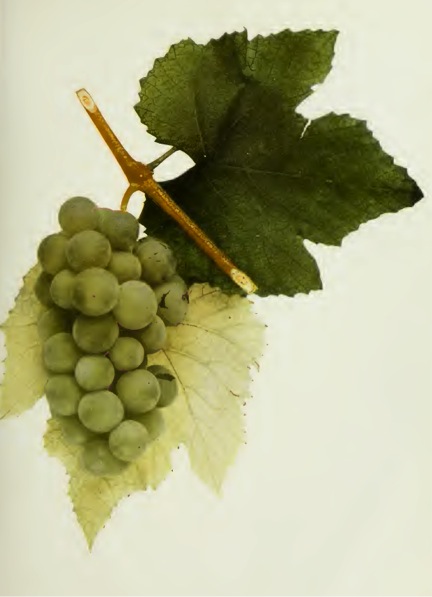 POCKLINGTON
POCKLINGTON
For a period at the end of the nineteenth century, this white seedling offspring of the Concord grape was the most popular white grape grown in the United States. It possessed much of the vitality and disease resistance of its native parent, proved better tasting than the Martha grape, the white variety that had stood foremost in growers' esteem in the mid-19th century, and presented only one liability as a crop option--late maturation--that made it sometimes fall victim to frost damange before becoming ripe. When the more cold tolerant Niagra grape was introduced at the turn of the twentieth century, the Pocklington lost favor in the more northern grape growing regions of the United States. Its lateness was less of an issue, of course, in the South. It remains preserved in the USDA National Clonal Germplasm Repository.
Ulysses Hedrick sketched the history of the grape: "John Pocklington of Sandy Hill, Washington County, New York from seed of Concord 1870. The variety was first exhibited at the New York State Fair in Rochester in 1877, and was exhibited before the American Pomological Society two years later" (Grapes of New York, p380). Its spread into general cultivation was rapid. The Pocklington was "sweet, rich, and pleasant flavored," perhaps moreso the either the Concord or Niagra, but possessed that touch of foxiess that marked native American species from European Vitis vinefera.
The berries tend to be large, oblate, yellow-green, and rimed with a dusty gray bloom. The skins are thin, mildly adhesive to the pulp, a touch astringent, and adorned with a scattering of russett dots. As the illustration shows, the berries cluster in a roughly cylindrical array.
"Among the many new white Grapes which claiming public attention just now, the Pocklington seems to have particular merits of interest . . . . This grape by birth and breeding may justly lay claim to being an 'Iron Clad.' It ust made its appearance in a cold and uninviting piece of soil in Washington county of this State, and is unquestionably an offspring of the Concord, crossed with some other variety--certainly not a foreign one, because such a grape could not be made to exist in that neighborhood, and had it been named the 'White Concord,' instead of bearing the name of its originator, it would have been most appropriate. It is a strong grower, with leathery foliage, and has never mildewed in the most adverse seasons. Its hardiness has been most severely tested, it having stood without protection or covering of any kind at Sandy Hill, on Mr. Pocklington's place, when the thermometer registered as low as 34 degrees below zero" A. M. Purdy's Description and Retail Catalog, Spring 1883 (Palmyra, NY), 22.
Nurseries that carried Pocklington white grapes prior to 1920:
Atlanta Nursery, Atlanta, GA 1891. Bluegrass Nursery, Lexington, KY 1891-1909. Cedar Cover Nurseries & Orchard, Salem, NC 1893. Clingman Nurseries, Kiethville, AL 1908. Eastern Shore Nursery, Denton, MD 1900. Excelsior Nurseries, Rome, GA 1890. Frederick Nursery, Frederick, MD 1897. Fruitlands, Augusta GA, 1893-99. Guilford Nuseries, Vandalia, NC 1897. Kentucky Nursery, Louisville, KY 1897. Milford Nursery, Milford, DE 1890. Munson Hill Nursery, Falls Church, VA 1908. Old Dominion Nursery, Richmond, VA 1894-1907. Peachland, Seaford, DE 1895. Peters Nursery, Knoxville, TN 1909. Silver Leaf Nurseries, Boones Path VA, 1888. Spring Hill Nursery, Prospect, VA 1894.
Image: Ulysses Hedrick, Grapes of New York (1908), 379.